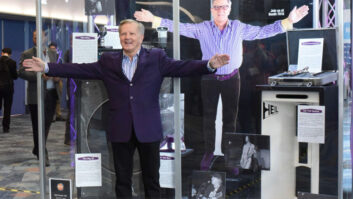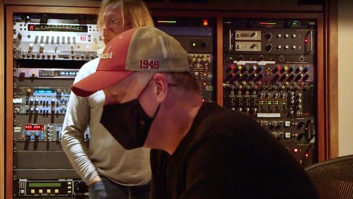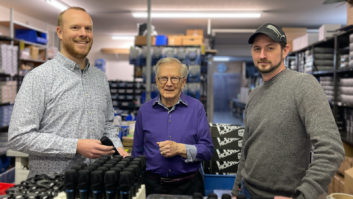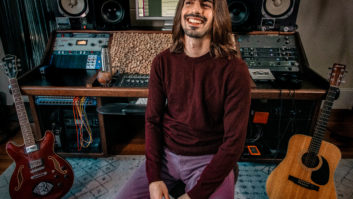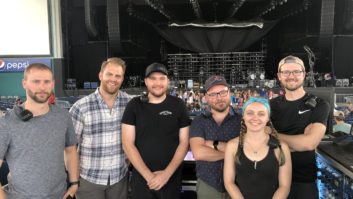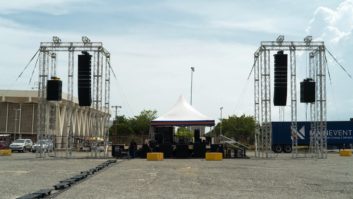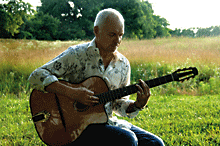
When I was first told that Peter Frampton was about to embark on a completely instrumental album — a tribute to his musical influences — my first thought was to try to convince him to include a duet with Warren Haynes playing slide. It occurred to me at the time that those two seasoned road warriors could create a kind of magic playing together that one rarely gets to hear. Frampton brings more than four decades of guitar-slinging to this latest project. He was trading licks with David Bowie at the tender age of 10, and by age 16, he had already enjoyed several hits in England with his band, The Herd. Frampton came to worldwide acclaim with Steve Marriott and Humble Pie in 1969. Frampton went solo in 1971, five years before his double-album Frampton Comes Alive! became one of the most popular live rock music albums of all time, selling more than 16 million copies. Consider also his 1977 Number One album and single, I’m In You; guest appearances on George Harrison’s All Things Must Pass and Harry Nilsson’s Son of Schmilsson; and his trademark “voice tube effect” for guitar, and it’s no wonder that the fair-haired British rocker has been elevated into the rarified realm of rock guitar gods.
Meeting Frampton in August of 2004 at his New York City hotel, I asked him about his new album, Fingerprints. “It’s basically a collection of [instrumental] music that I decided to one day do because playing guitar has always been my passion,” he says. “I love singing, but as I said the other day to someone, if I had to choose something that I couldn’t do anymore out of writing, singing or playing, I would choose to lose my voice!” [Laughs]
“The first person that really gave me the bug [for guitar playing] was Hank Marvin from The Shadows, which started off as Cliff Richard’s backing band and then became an entity unto themselves,” Frampton continues. “In the old Commonwealth countries, they became the instrumental Beatles! They were a phenomenon! They were much, much bigger than The Ventures in America to us, even though I loved them, too. It must have been ’58 or ’59 when I first saw the red Stratocaster with a tremolo strapped round Hank Marvin’s neck. He’d modeled himself look-wise after Buddy Holly, with the big horn-rimmed glasses. So, really, I guess we can blame Hank Marvin for me!

“If you speak to Mark Knopfler, Pete Townshend, Jeff Beck, Keith Richards, they’ll all mention Hank at some point in their beginnings,” Frampton continues. “He was the guru for us. On and off, over my entire life, I’ve been saying I would do an instrumental album. The germ of the idea has always been there, but it went into second gear when I played in 1995 — for the first time in many, many years — at the Shepherd’s Bush amphitheater, when Hank Marvin came and saw our show. As it happened, that tour we walked on [stage] to The Shadows’ ‘FBI’ single and walked off to The Shadows’ ‘Nivram.’ We did it every night.
“So he comes backstage and, basically, I ignore everybody else that had come to see me. At that point, I asked Hank, ‘Would you do me the honor of playing on an instrumental album I’m planning to do? You’re the reason why I started playing guitar.’ And he said, ‘Of course!’ So 10 years later, I e-mailed him, and I said, ‘I know it’s been awhile, but I’m ready. Are you still up for it?’ And he just e-mailed me back with a very simple reply: ‘I thought you’d never ask.’ Getting Hank was the most important thing to me.”
As I listened to Frampton describe his project, I became even more convinced that Haynes would be a great addition to his guest roster, and when I finally broached the subject, I was thrilled to find that Frampton was interested. I wound up calling Haynes straightaway to give him Frampton’s contact information, trusting that the stars would align and nature would take its course. Months later, while Haynes was touring with Gov’t Mule in Cincinnati, he asked Frampton to sit in with his band. They got along wonderfully, as I suspected, and nearly 18 months after my first meeting with Frampton, I got a call from Haynes asking me to do the recording for the dueling solos session I’d suggested. It was certainly worth the wait.
We finally set up on March 12, 2006, in Right Track Studio A on 48th Street in New York City. Both Frampton and Haynes played Gibson guitars through matched Soldano SLO-100 heads. Frampton’s head went to a slanted Marshall four-by with 25-watt Celestions located in the iso booth next to the control room. Haynes’ head also went to a greenback Marshall four-by, but it was out in the large room for separation. Both bottoms were miked with a Shure SM57 and a Sennheiser 421. (Warren’s were adjacent, on one driver, at 45-degree angles to one another, with the 421 straight on the driver, halfway between the driver’s edge and the element, and the 57 perpendicular to the angle of the cone.) Frampton’s mics were placed on different drivers (the top two), both straight on and equidistant from the center and the edge of the cones. Two Neumann U87 room mics were placed for Haynes’ ambience, about 16 feet apart and about 16 feet from the Marshall bottom. (Frampton’s performance was later played out through studio loudspeakers and recorded through Haynes’ room mics to add the same ambience.) All of the mics went through Neve 1081 mic preamps, flat and direct to Pro Tools.
AINLAY IN THE STUDIO
When I put up the blues track we were to work on, the first thing I noticed was the rich drum sound on the submix Frampton had brought. “There’s no ‘verb on that,” he told me. “That’s the sound of my room!” I later asked Nashville engineer Chuck Ainlay (who did all the tracking for Fingerprints) what working in Frampton’s home studio was like.
“The room sounds great,” Ainlay says. “Well, Chad Cromwell — his drums sound great anyhow, but [it’s not like] those real large rooms where the drums kind of just get lost in them. Peter’s room creates [just] enough compression. It sort of loads up, but doesn’t load up too much. He’s also got a lot of other usable spaces. We basically utilized the whole house while his wife was out of town. We were able to use the upstairs for the piano and the guitars, and there’s a big TV/den/children’s playroom off the studio, which we used for his guitar rig. Then he’s got an exercise room, which just sounds amazing. We did a couple of guitars in there.
“I love recording to tape. It knocks off the transients on the drums and you can get them louder. You just have a bit more headroom and it also sort of takes off that brittle high end. It warms things up.”
“BLOOZE”
Magic is often harder to come by in a recording studio than in a live venue, but there was magic between Haynes and Frampton on the very first incredible take of “Blooze,” which is now the title of the song Haynes and Frampton played on together. It was decided that Frampton would play verse one, Haynes on verse two and both musicians trading licks on verse three. The pair went for it. Frampton was so captivated by Haynes’ playing on the intro that, for a moment, he forgot to play his part in verse one. With the exception of that slip, and a few better licks that were taken from one of the other two takes we did, the entire final performance was from take one.
“It was great,” Haynes tells me later. “I mean, he plays amazingly, and we were able to communicate right from the beginning. You know, there’s nothing like a great first take when it happens. I felt like the first take had that natural flow about it that the following takes didn’t have.”
MUSICAL CONVERSATION
More recently, I caught up to Frampton while he was in Chicago, on tour, and had the chance to ask him a few more questions.
Has owning your own studio liberated you creatively?
Liberating is definitely one of the words I would use to describe it. I’ve always had some form of studio. As much as I’ve been a guitar player and a songwriter, I’ve always been very involved in electronics.
What kind of console do you have?
I have an SSL E Series with a G computer, 56-in, and I love it to death! I got that because it’s a standard, and a lot of people still like to mix on it. Also, I’ve been collecting outboard mic pre’s: Neve [1081 and 1073], Vintech [473 and X81], Universal Audio [2108 and 610], an old Jensen. I’ve got enough to do a complete drum kit with skins on top and underneath. [Laughs]
Who designed your home studio?
I had been to many, many studios. I remember going to the Townhouse, the Phil Collins room, and the combination of surfaces in that room was wood, stone, a little bit of fabric and no parallel walls! And it was very tall. It was the smallest room, but very tall. And the drum kit got set up right in front of a stone-faced fireplace that went from floor to ceiling. So, basically, I made my studio area [like that]. I call it the drum room. If the drums don’t sound good, I’m frustrated. That’s where it all starts. The drummer drives the band, and the drums have to sound great. I have sidewalls of cherry wood, the complete wall behind the drums is stone and then, opposite where the drums face, I have a little bit of padded fabric and more wood.
So you did it yourself, based on your experiences in the past.
Yes. But I did have someone: Dave Mattingly, who built Chuck Ainlay’s studios, Backstage and Soundstage, and a lot of other studios around the country. I know the ingredients of a great studio, and he knew how to make a great control room and how to make a control room sound. And I’m not using big speakers; I’m only using near-fields with a subwoofer. So it was hit or miss. But I have to credit Dave Mattingly with building me a phenomenal studio.
Could you share a memory of one of those moments in your career when an accident or something completely improbable turned out to be wonderful?
Some of my better-played solos [occur] when I don’t think about what I’m playing. The session with Warren was like that. We only did two or three takes of my solo and then we chose between them. I’m trying to emulate what happens onstage, which is what I think we did on Warren’s session. It was as live and as off-the-cuff as it could possibly be. I didn’t even tell Warren what the chords in the bridge were! I have to say that those are the happy accidents. We said, “Shall we talk about this or not?” and we both said, “No. Let’s just go for it. Let’s just do it.” And [almost all of it] is the first take! That’s magic! That’s the best that can happen, when there are questions and answers, and we talk over one another, just like you do in conversation.
